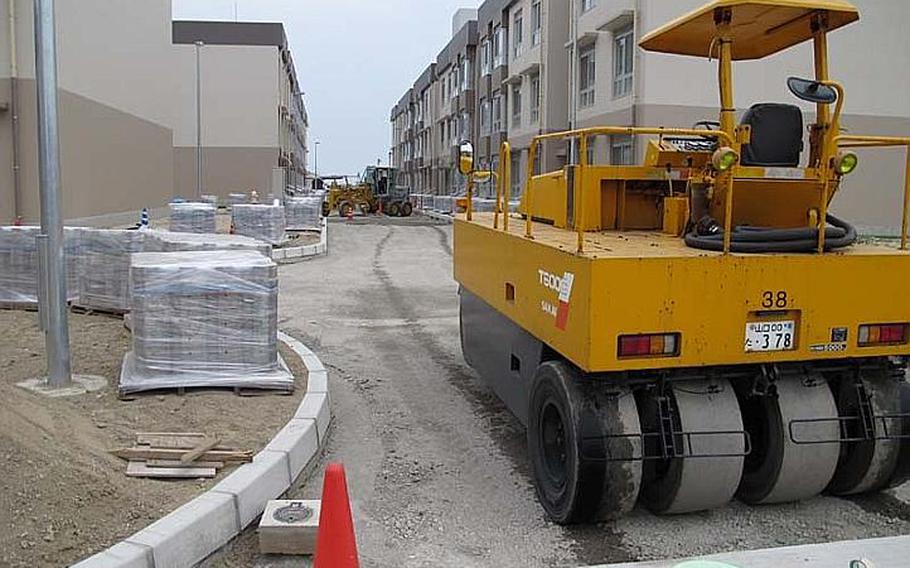
Construction to support the upcoming realignment of U.S. forces in the Pacific has taken its toll on residents at Marine Corps Air Station Iwakuni. Despite safety concerns, issues with traffic, and disappearing recreational opportunities, servicemembers and their families are optimistic about the future of the base. On the base's north side, construction on new barracks is under way. (Matthew M. Burke/Stars and Stripes)
MARINE CORPS AIR STATION IWAKUNI, Japan - Face lifts are painful and potentially hazardous - just ask residents of Marine Corps Air Station Iwakuni, where the U.S. military's Pacific realignment is in full swing.
The base population is scheduled to double to approximately 10,000 residents by 2014, when Iwakuni receives a squadron of KC-130 aircraft and Carrier Air Wing 5 relocates from Naval Air Facility Atsugi west of Tokyo.
The construction and development of infrastructure to support the additions has been ongoing for several years, frustrating base residents and impeding daily life. In some instances, it has even become a safety hazard, according to Marines stationed there.
The main problem is that "the construction is constantly changing," said Staff Sgt. Matthew Lowry, ground safety officer of Marine Aviation Logistics Squadron 12. "Every time you turn around, there is a new obstacle in our way."
Lowry and other safety representatives on the base said frequent relocation of stop signs and increased traffic congestion have led to several near-accidents involving drivers, pedestrians and cyclists.
"We've had a lot of close calls," Lowry said.
Marine officials said they do their best to get the word out about changes, using television, radio and the Iwakuni Approach newspaper, but they can't reach everyone.
"We're reconstructing over 70 percent of the base in the next few years," said Edward Cutshall, Marine Corps Defense Policy Review Initiative program director. "We're going to have to re-route a lot of roads. We're going to have to cut a lot of roads. Everybody, over time, will be inconvenienced a little bit."
Most of the upheaval is on the north side of the small base by its only civilian gas station, including road work and the construction associated with new barracks facilities. Some of the hiccups include ever-present barriers and heavy equipment, confusing detours through parking lots and one-way streets, and fences erected in the middle of the road.
The congestion can be frustrating, said Sgt. Gaylon Summers, who said he must deal with traffic on his way to and from work near the north side of base. He said traffic at lunchtime is also really bad.
"People are worried it will be really congested when the new people get here," he said.
Summers' wife, Sarah Beth, works in the human resources department on the other side of the base she calls a "maze," away from most of the heavy construction.
"Sometimes it's annoying because you might have to go out of your way, but overall I think it's good for the base," she said.
Despite being a massive undertaking, the construction is on schedule thanks to around-the-clock work, Cutshall said, and is expected to be completed by March 2015. This includes a new Marine Aircraft Group flight line with new hangars, a maintenance facility, firefighting facility, administrative building and boiler chamber. The commissary, Marine Corps Exchange and child day-care center will all grow appropriately as well, Cutshall said.
The biggest challenge is trying to do multiple projects at the same time while keeping the base operational, he added.
The contracts for the projects - being completed by Japanese contractors - were signed from April 2009 to March 2010, according to Masahiko Morishima, Chugoku Shikoku Defense Bureau spokesman. He was unable to provide the total cost of the project but said expenses for the April 2011-March 2012 Japanese fiscal year alone was 55.8 billion yen, or more than $700 million, paid by the Japanese government.
The construction will give MCAS Iwakuni a completely new look.
In 2010, a new heavy-lift runway was completed. In December, a new runway and terminal facility will open for commercial flights. Officials hope it will provide a boon to the sleepy city's economy and make it easier for servicemembers to travel. It will even speed up the mail service to Iwakuni, shaving at least a day or two off for residents and servicemembers alike, Cutshall said.
Future projects are expected to include more U.S. military housing units on Mount Atago, which was partially leveled for landfill to build the heavy-lift runway, even though the land has yet to be furnished to the U.S. government.
Cutshall said even though agreements still need to be worked out, a massive shared use recreational complex is also planned for the site, complete with a cultural center, tea room, indoor volleyball and basketball courts, as well as baseball and soccer fields like Nimitz Park in Sasebo, only double or triple the size.
The air station is also slated to receive four new schools by 2016 to replace the two it currently has, according to outgoing Matthew C. Perry High School principal Morgan Nugent. There will be two elementary schools, a middle school and a high school, he said. Construction has yet to begin and costs are still being negotiated with the Japanese.
The high school will field a junior varsity football program next year for the first time, on a new sports field that was completed in June using sod from the station's golf course, Torii Pines, which closed April 1.
Sgt. Gaylon Summers, ground safety manager for MALS-12, said the most frequent complaint he hears about the realignment concerns the loss of the golf course, which was one of the few recreational activities available on the base. Housing will take its place, Cutshall said.
"I'm an avid golfer and I'm sad to see it go," Lowry said of Torii Pines, now leveled dirt, pockmarked with puddles and torn up with tire tracks. "But you gotta take the good with the bad."